
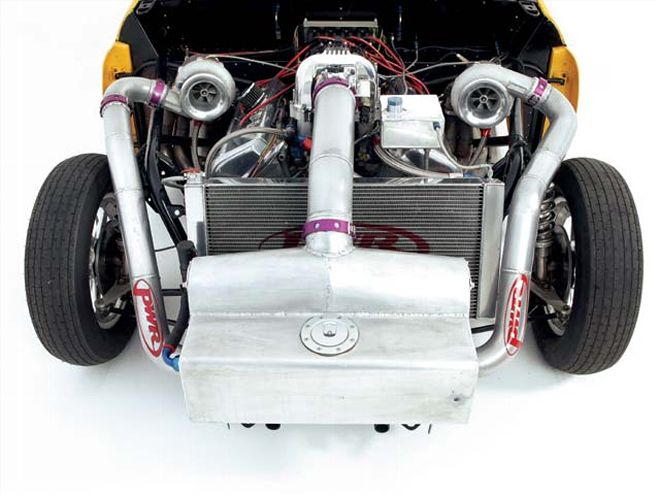 The world's fastest mod-motor-powered car, owned and driven by Accufab's John Mihovetz, relies on an Electromotive EFI system to generate close to 2,000 hp.
The world's fastest mod-motor-powered car, owned and driven by Accufab's John Mihovetz, relies on an Electromotive EFI system to generate close to 2,000 hp.
Let's just get this out of the way up front. For the average street machine, EFI isn't about making more horsepower. It's not about simplicity or saving money either. The good ol' carburetor has had that covered for more than a century. Even those of us who've picked our knuckles up off the ground would agree. To top it all off, the ugliness of errant wires and sensors requires innovative solutions on the OE level--like slapping on engine covers. So why go EFI?
Despite its higher initial cost of entry and reputation for fussiness, once EFI is set up properly, no Dominator or Q-jet can come close to the driveability, reliability, lack of maintenance, and consistent performance EFI delivers. EFI also offers reduced emissions and improved gas mileage (for those of you who care about that sort of thing). Whether you're looking to trade in your carb for a computer, want to step up from a factory PCM to a standalone, or just train your stock computer to play nice with big cams and blowers, the options are many, and getting started isn't as hard as you may think.
Since consumer intimidation is inversely proportional to profits, the aftermarket has taken great measures to make the transition from carb to EFI as painless and simple as possible. Here's a look at some of the more popular EFI systems on the market plus some tips on how to get started.
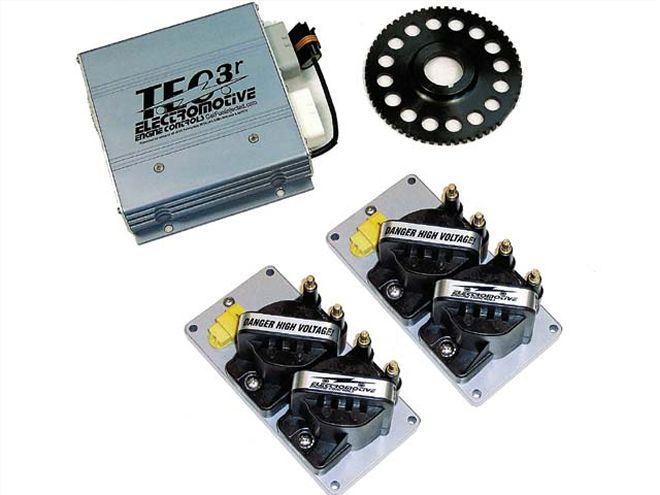 A high-output distributor and crank-trigger make the Electromotive TEC3 incredibly accurate.
A high-output distributor and crank-trigger make the Electromotive TEC3 incredibly accurate.
STANDALONE EFI SYSTEMS
Despite the amazing potential for tuning factory computers afforded by relatively inexpensive software, these programs still have their limits. The inability to use low-impedance injectors caps power, and only an aftermarket computer offers real-time tuning capability while the motor is running. The biggest disadvantage is the most obvious--tuning software for factory computers is not available for all engine types.
If that's the case, the only option is going to a standalone aftermarket EFI system. Kits usually include a PCM box (computer), a wiring harness, sensors, tuning software, and a cable that interfaces with a laptop computer. The end-user typically supplies the remaining fuel system components, and less popular applications may require custom hardwiring of a generic wiring harness. These systems can also be used to convert carbureted induction to EFI as long as you don't mind the onus of piecing parts together and doing some minor fabrication work.
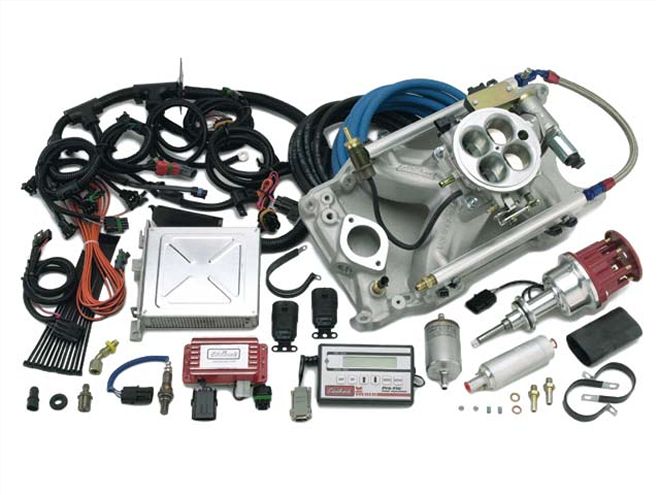 Edelbrock's Pro-Flo handheld calibration module eliminates the need for a laptop computer. Edelbrock also offers Victor and Super Victor intakes that can be combined with its universal EFI kits for serious horsepower potential.
Edelbrock's Pro-Flo handheld calibration module eliminates the need for a laptop computer. Edelbrock also offers Victor and Super Victor intakes that can be combined with its universal EFI kits for serious horsepower potential.
Edelbrock
From vapid 350s to killer big-blocks, Edelbrock can manage them all with its multiple EFI system offerings. One of the most user-friendly of all carb-to-EFI upgrades, Edelbrock's semi-sequential-fire Pro-Flo EFI system is available for small-block Fords, AMCs, Jeeps, and small- and big-block Chevys and Mopars. The system bundles together an intake manifold, fuel rails, injectors, fuel-pressure regulator, a high-pressure fuel pump, a carb-style throttle-body, a wiring harness, an ECU, and all necessary sensors. To help even the most clueless users get started, Edelbrock supplies a plug-in chip for your ECU custom calibrated to engine specs you provide your friendly Edelbrock tech support rep after the time of purchase. Once a baseline program is established, fuel and timing maps and idle speed are fully adjustable with a handheld calibration module. Prices start at about $2,000.
Edelbrock's new Pro-Tuner EFI system, designed in conjunction with MotoTron, boasts serious hardware for extreme competition motors producing up to 1,500 hp. Kits are based on either a Victor or Super Victor single-plane manifold converted for EFI use and include fuel rails and injectors. The heart of the system is a MotoTron ECU and Windows-based tuning software, complemented by all necessary wiring, sensors, and a distributor. A four-barrel throttle-body, a fuel-pressure regulator, and a high-flow external fuel pump complete the package. Pricing is yet to be announced, but look for small-block Ford, Pontiac, and small- and big-block Chevy systems to hit the shelves later this year.
Holley
For the more audacious, Holley's batch-fire Commander 950 fuel-injection system offers the straightforward installation of a complete bolt-on system with the flexibility of powerful tuning software should you decide to get more serious. The kit boasts the potential to support 950 hp and includes an intake manifold, a 1,000- or 2,000-cfm billet throttle-body, fuel rails, injectors, a fuel-pressure regulator, a high-pressure fuel pump, a wiring harness, an ECU, and sensors. The Windows-based software includes a plethora of baseline programs for a vast range of applications. Uploading a program for a combo similar to yours gets you up and running, and more files are regularly added to Holley's Web site and are available for downloading. Hard-core street/strip warriors will appreciate the optional race software upgrade that features data logging (up to 2.5 minutes), wastegate control, provisions for rpm-activated switches, and a wideband O2 sensor upgrade. Systems are available for small- and big-block Chevys and small-block Fords. Prices start at $2,300.
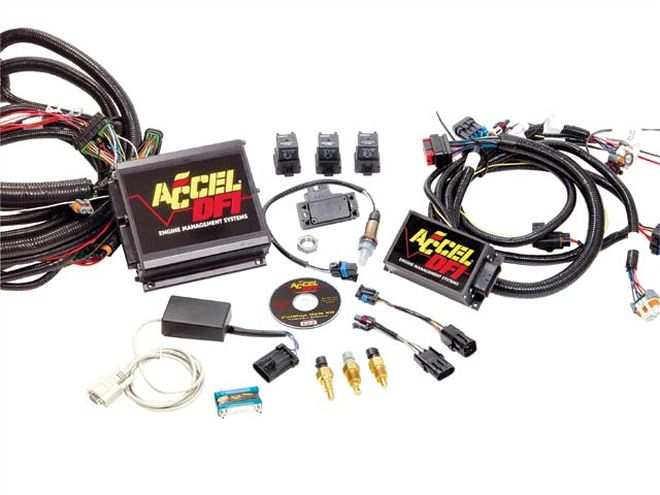 ACCEL offers plug-and-play harnesses for popular Ford and GM applications.
ACCEL offers plug-and-play harnesses for popular Ford and GM applications.
Accel DFI
When ACCEL replaced its venerable Gen VI DFI system with the new Gen VII, critics balked that its software was too cumbersome to navigate. In response, ACCEL's CalMap software has been refined, and certain tuners swear by the Gen VII as the high-end system of choice. After you enter bore and stroke dimensions, compression ratio, cam specs, fuel pressure, injector size, and cylinder head specs, CalMap automatically generates a custom baseline program to get you up and running. Tweaking the fuel maps is simply a matter of entering a target air/fuel ratio. The PCM takes that figure and adjusts injector pulse width accordingly. Additional features include the choice of batch or sequential-fire injection, nitrous control, torque-converter lockup functions, a two-step rev-limiter for turbo cars, and separate fuel and spark maps for starting-line launches. The bottom line is that it may take some practice to master, but the Gen VII is a very powerful piece of equipment. Prices start at $1,400.
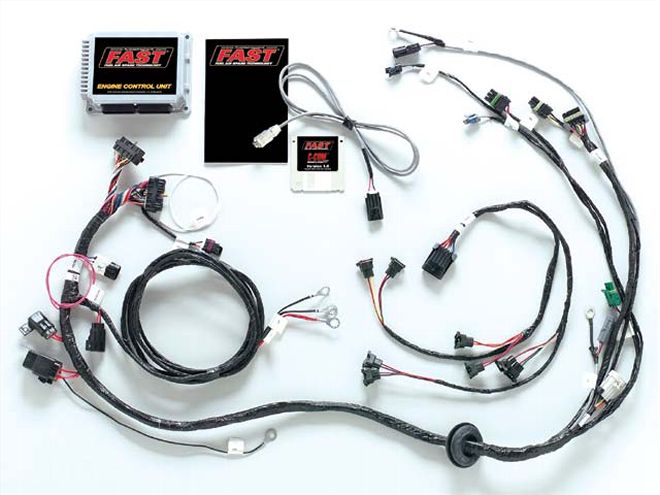 Though FAST software includes data logging, an optional remote data logger can record up to 30 minutes of data without a laptop computer on board.
Though FAST software includes data logging, an optional remote data logger can record up to 30 minutes of data without a laptop computer on board.
FAST
Though we don't have the capacity to conduct an official survey, FAST's EFI system is probably the most popular on the market, and with the introduction of the company's newest system, it's sure to continue to be. Previously, you had to choose between one of two systems: a bank-to-bank PCM that fires four injectors at a time every 180 degrees of crankshaft rotation, and a sequential system for more precise fueling. The new system, called XFI, allows either setup in the same box. In fact, unlike previous versions, the new FAST box comes only one way, eliminating the pesky additional (and extra-cost) options. In a nutshell, the FAST PCM can control every aspect of the engine, from fuel to spark to fans and other accessories, and it even has controls for an electronically controlled transmission. Thanks to the added accuracy the wideband O2 sensor affords, the system can run in closed loop under WOT. That means the PCM still reads the input from various sensors to adjust the ignition and fuel even when under full steam instead of relying on preprogrammed maps. The results are greater adaptability to changing atmospheric conditions and more leeway for the end-user in dialing in the tune. Prices start at $1,000.
Electromotive
Whereas most aftermarket EFI systems use time-based calculations to determine spark and ignition phasing, the Electromotive TEC3 measures crank position with a trigger wheel for purportedly greater accuracy. The patented Direct Fire ignition system features a separate coil pack for every pair of companion cylinders, which according to Electromotive, provides more energy and 10 times more spark duration than competing capacitive-discharge systems. How much all that's worth on your average street/strip motor is difficult to quantify, but many demanding small-displacement forced-induction applications prove it's not all just a marketing myth. Tuners can also control turbo boost, nitrous, torque-converter lockup, shift lights, cooling fans, and a three-step rev limiter. As with ACCEL's Gen VII DFI, Electromotive's WinTEC 3.0 software creates a baseline program based on engine specs you enter, can automatically adjust injector pulsewidths to match a target air/fuel ratio, and supports either full sequential or semi-sequential operation. Additionally, an integrated data-acquisition system allows data logging without having a laptop on board. Prices start at $2,500.
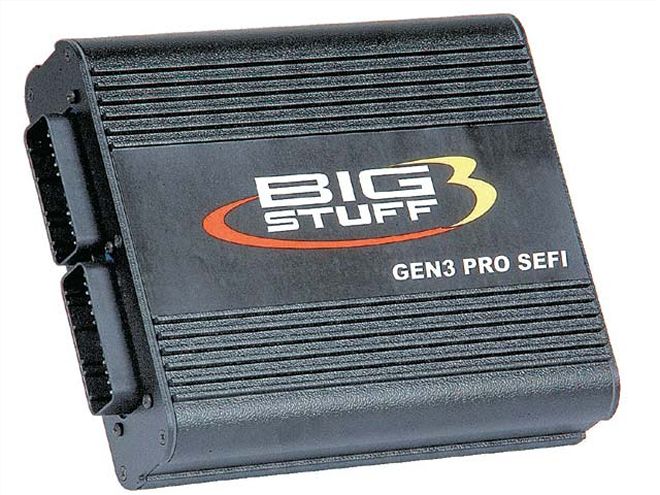 The BigStuff3 PCM can also control torque-converter slippage and lockup on GM 4L60E and 4L80E transmissions.
The BigStuff3 PCM can also control torque-converter slippage and lockup on GM 4L60E and 4L80E transmissions.
BigStuff3
Call this one the sleeper of aftermarket EFI. It's not as widely used as some of the other systems on the market, but John Meaney--the Godfather of aftermarket EFI and the man behind BigStuff3--invented the standalone systems that eventually became known as ACCEL DFI and FAST. With that kind of track record, you'd expect innovation, and that's exactly what BigStuff3 delivers. The fully sequential PCM is based on a Bosch 16-bit processor swiped from the Indycar world that's many times faster than the 8-bit competition, according to BigStuff3. This enables the onboard data logger to record as fast as 50 times per second from up to 50 different channel inputs. A wideband O2 sensor lets you know what each bank of cylinders is doing, and spark and fuel control for each individual cylinder help compensate for poor intake manifold designs. For a variety of needs and budgets, BigStuff3 can be used either in a time-based phasing mode or in conjunction with an MSD crank trigger. Turbo motors also benefit from an optional five-bar MAP sensor, two- and three-stage boost control, a multistep rev-limiter, and the ability to measure turboshaft rpm. Other features include torque-converter slippage and lockup controls, and an integrated accelerometer. As with ACCEL and Electromotive's software, the input of basic engine parameters generates a baseline program, and BigStuff3's self-learning wideband capability automatically adjusts fuel and timing curves under part- and wide-open throttle. Prices start at $1,995.
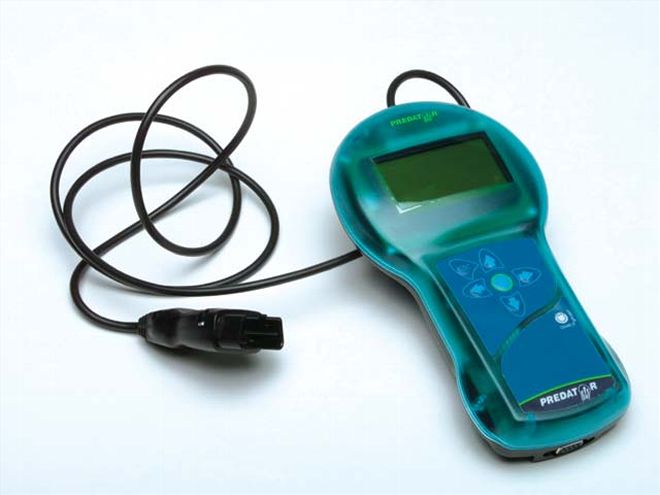 For most street machines, handheld programmers like Granatelli Motor Sports' Predator have more than enough tuning power for basic tuning needs.
For most street machines, handheld programmers like Granatelli Motor Sports' Predator have more than enough tuning power for basic tuning needs.
Handheld Programmers
Right when this market segment seemed doomed because of cheaper and more powerful tuning tools like the PMS and HP Tuners software, a slew of new players from Superchips, JET, Granatelli, and Crane Cams joined the Hypertech Power Programmer to cover almost every late-model performance vehicle and truck on the market. The downside of handheld programmers is that their programs are somewhat generic.
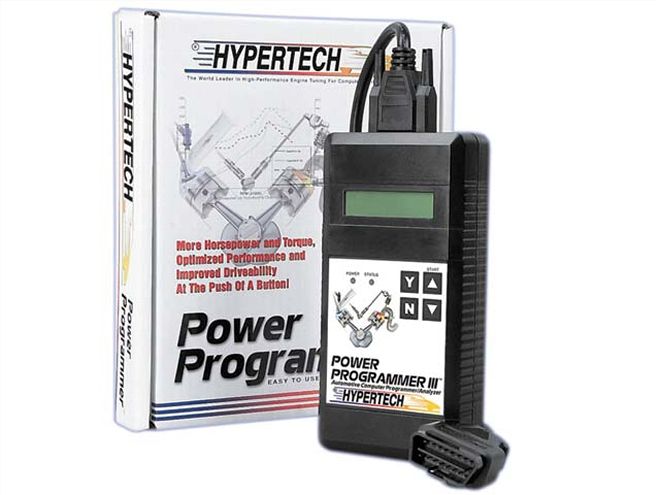 Hypertech was one of the first aftermarket computer-chip tuners. Its Power Programmer allows quick flash-programming for improved performance.
Hypertech was one of the first aftermarket computer-chip tuners. Its Power Programmer allows quick flash-programming for improved performance.
They typically have a number of preprogrammed maps to pick from that most closely match your engine's combination. From there, some programmers allow further alteration of the fuel and ignition curves. What they lack in ultimate sophistication, handheld programmers make up for in user-friendliness, as they don't require learning how to interpret and navigate dozens of different programming screens. Additionally, they can adjust rev limiters, shift points, speed limiters, and cooling-fan activation points, plus display live data from sensors and scan and erase trouble codes. Most also allow you to compensate for a change in tire diameter or rear gear ratio. Although they may not suffice for heavily modified combos, they'll work just fine for most stock or mildly modified street machines.
Tuning for Late Model Engines
HP Tuners
Good news for us: GM's mighty Gen III small-block comes with an equally mighty computer to control it. The brainchild of an elite group of bandit hackers, Windows-based HP Tuners VCM Suite Pro software allows full alteration of fuel and ignition curves within the factory PCM using a laptop computer. Just as with a full-on standalone system, the software displays live fuel, spark, rpm, coolant temperature, manifold vacuum, O2 sensor, and throttle-position readings. In addition to data-logging capabilities, the software allows control over cooling fans, transmission shift points, and speedometer calibration and has provisions for additional ancillary inputs such as wideband O2 sensors. Truly astonishing for a setup that reflashes the stock computer, files are uploaded in mere seconds and optional two- and three-bar MAP sensors for forced-induction applications means big boost can be had without aftermarket EFI. Pricing starts at $499--which includes a software CD and interface cable--and applications include all GM Gen III small-blocks and late-model GM V-6s. Visit www.hptuners .com for more info, to place an order, or to ask questions on the HP Tuners message board for helpful tuning tips.
PMS
The 5.0L Mustang is still the King of affordable late-model performance, and Anderson Ford Motorsport's Programmable Engine Management System played a large role in crowning Ford's small-block. Available for '86-'05 EEC-IV and EEC-V PCMs for 5.0L and mod-motor Fords, the PMS piggybacks onto the factory computer and yields a dizzying array of tuning options. Adjustments are made on the unit itself, so no laptop computer is needed. In addition to increasing the computer's memory capacity, the PMS allows full alteration of fuel and spark maps, bumping the rev limiter up to 9,900 rpm, separate nitrous and boost adjustment tables, real-time engine monitoring, two-step rev limiters, three-bar MAP sensors, and cooling-fan control. An optional low-impedance driver lets you run big injectors, and the PMS can also interface with a laptop computer for data logging. AFM helps you get started by providing a baseline program already loaded into your PMS based on the engine specs you give them. Prices start at $850.
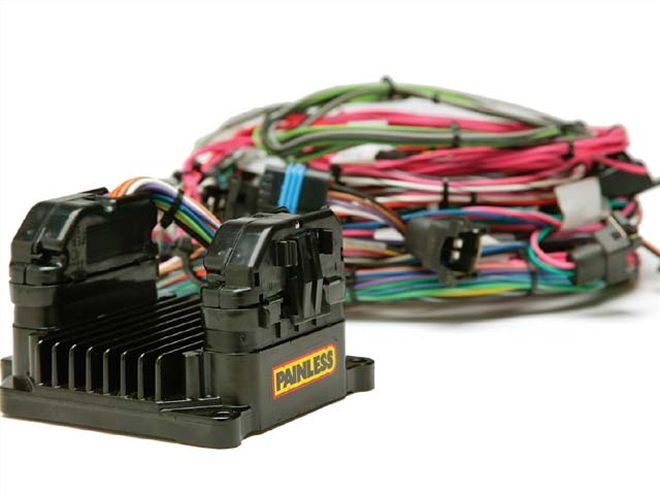 The company known for plug-and-play wiring harnesses, Painless now has a computer and wiring harness to make EFI swaps into older cars a piece of cake.
The company known for plug-and-play wiring harnesses, Painless now has a computer and wiring harness to make EFI swaps into older cars a piece of cake.
Painless PERFECT
Say you scored a sweet deal on a late-model EFI motor at the junkyard or on eBay but it didn't come with a computer. Painless Performance has you covered with its new Perfect engine management system. And it really is painless. The fully plug-and-play system comes with a weather-resistant computer preprogrammed for near-stock applications that Painless says boosts horsepower and gas mileage, and a wiring harness that mates to OE sensors. The company will soon offer software allowing further fine tuning. The system is currently available for Chevy 305 and 350 TPI motors and the LT1. Ford 5.0L, mod motor, Chevy LS1, and Mopar 5.7L Hemi applications come later this year. Pricing starts at just under $1,300.
lS1-EDIT
Carputing revolutionized late-model GM EFI tuning with the introduction of LT1-Edit in 1999, which allowed levels of tunability typically associated with aftermarket computers at a fraction of the cost. The rapid growth of the LS1 market led to the development of LS1-Edit, available for all '97-and-up GM vehicles equipped with Gen II small-blocks. The $450 package includes easy-to-use Windows-based software and interface cable, and enables full control over fuel and spark maps. Other features include a data logger, speedometer recalibration, and cooling-fan, rev-limiter, and shift-point control. The software also works as scanner by displaying trouble codes and allowing users to erase them. Each LS1-Edit package will only work on the VIN stored in your PCM, but additional VINs can be purchased for $100 each. Log on to www.carputing.com for more details or to place an order.
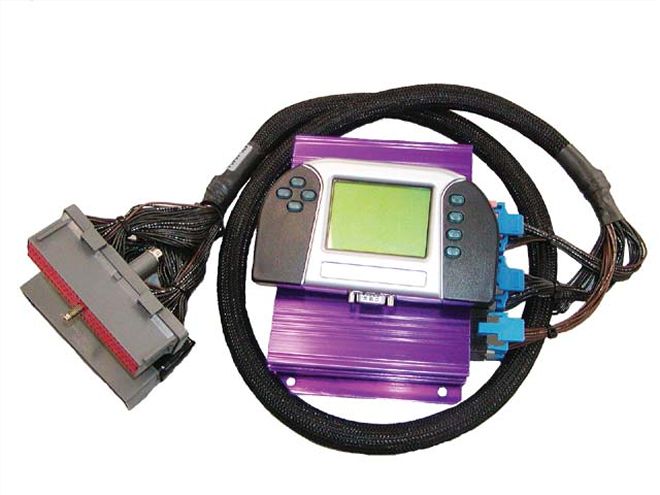 Anderson Ford Motorsport's PMS is anodized for durability and is water resistant
Anderson Ford Motorsport's PMS is anodized for durability and is water resistant
TWeecER
One of the biggest pains of tuning stock computers is waiting minutes for your reprogrammed files to upload. The TwEECer lets you program up to four different calibrations and switch between them while the engine is running. For example, you can change from a fuel economy to a performance or nitrous tune on the fly. A fifth mode allows switching back to a stock program. The TwEECer plugs into the service port on EEC-IV and EEC-V Ford ECUs and allows full alteration of fuel and ignition curves with a laptop computer. The CalEdit software features an easy-to-interpret graphical display, and an optional data logger can record up to 10 samples per second of information. The base kit, which includes the TwEECer, interface cable, and software CD, is priced at $380 and the optional data logger runs an additional $170.
Time to hire a pro
If you've never tuned EFI before, it's easy to get lost, especially with a standalone system. There are a bunch of tables and options and it can be intimidating. Even if you get the car running, you're probably leaving power on the table. Here's where to go to find a pro to either bail you out and get the car running, or to tune it for maximum power.
West
Arizona TPI Inc;
Tempe, AZ; 480/921-2500;
www.arizonatpi.com (DFI, Painless)
Bill Nelson's Automotive Service;
Tucson, AZ; 520/747-5900;
www.billnelsonauto.com (FAST, DFI, BigStuff3)
Blower Drive Service;
Whittier, CA; 562/693-4302;
www.blowerdriveservice.com (FAST, BigStuff3)
Blue Oval Performance;
Vancouver, WA; 360/993-1745;
www.blueovalperformance.com (DFI only)
B&R Automotive;
Phoenix, AZ; 602/272-6474
(FAST, DFI, Electromotive)
The Dyno Shop;
Santee, CA; 619/562-3933;
www.thedynoshop.com (FAST, DFI)
Fast Track Performance;
Ferndale, CA; 707/786-4094;
www.fasttrackperformance.com (FAST, DFI)
Force Fed Performance;
Sacramento, CA; 916/331-1611;
www.forcefedperformance.com (FAST, DFI)
Pro Dyno;
Tempe, AZ; 480/967-5550;
www.prodyno.com (DFI)
R&E Racing;
Lancaster, CA; 661/948-7622;
www.re-racing.com (DFI)
Speed Merchant;
San Jose, CA; 408/295-0930;
www.speedmerchant.com (FAST, BigStuff3)
Central
ADC Racing Engines;
Fort Collins, CO; 970/482-1927;
www.adc-racing.com (DFI)
Area One Motorsports;
Franklin Park, IL; 847/671-6969
(Electromotive)
ASSC Racing;
Lake Bluff, IL; 847/473-4720;
www.asscracing.com (BigStuff3, DFI)
The Carburetor Shop;
Englewood, CO; 303/781-1118;
www.thecarburetorshop.net (DFI, Electromotive)
CCS Motorsports;
Austin, TX; 512/828-0227
(Electromotive)
Competition Parts;
Austin, TX; 512/445-6707
(BigStuff3)
Conley Performance Plus;
Houston, TX; 281/540-3278
(DFI, BigStuff3)
Dynotech Engineering;
Fort Wayne, IN; 260/407-5455;
www.dynotech-eng.com (DFI)
EFI Conversions;
Ham Lake, MN; 763/757-6597
(DFI)
Fuel Injection Specialties;
San Antonio, TX; 210/654-0774;
www.fuelinjection.com (DFI, FAST)
High Tech Motorsports;
Ramsey, MN; 763/712-9088
(Holley, DFI)
Kinsler Fuel Injection;
Troy, MI; 248/362-1145; www.kinsler.com (DFI, FAST)
Maxximum EFI;
Frasier, MI; 810/397-4084;
www.maxximumefi.com (DFI, FAST)
Murillo Motorsports;
San Antonio, TX; 210/946-1199;
www.murillomotorsports.com (SCT, FAST)
Nu-Tek Motorsports;
Findlay, OH; 419/427-3330
(DFI, FAST)
Sunset Racecraft;
Lubbock, TX; 806/747-2700;
www.sunsetracecraft.com (Holley)
White Racing & Marine;
Warren, MI; 586/756-3026
(BigStuff3)
East
Atlanta Chassis Dyno;
Covington, GA; 770/786-2400
(FAST)
Bennett Racing;
Haleyville, AL; 205/486-5520;
www.bennettracing.com (FAST, DFI)
Borrel Auto Repair;
Abington, PA; 215/659-8547;
www.injection-connection.com (FAST, DFI, BigStuff3, Holley)
Cartek Racing;
Garwood, NJ; 908/317-4496;
www.cartek.net (BigStuff3, DFI)
Force Fuel Injection;
Miami, FL; 305/235-6160;
www.force-efi.com (FAST, DFI)
Hartline Performance;
West Melbourne, FL; 321/722-1563;
www.hartlineperformance.com (FAST, DFI)
Holley Performance Products;
Bowling Green, KY; 270/781-9741 (tech); 800/HOLLEY-1 ext. 8530 (nearest dealer);
www.holley.com
IDA Automotive;
Morgansville, NJ; 908/591-1245
(Holley)
J&M Corvette;
Manchester, CT; 860/645-6389;
www.jandmmotorsports.com (DFI)
Kennedys Dynotune;
North Tonawanda, NY; 716/693-5354
(Electromotive, DFI, FAST)
Maryland Performance;
Baltimore, MD; 301/258-8883
(Holley, DFI, BigStuff3)
Norris Motorsports;
Alamonte Springs, FL; 407/869-7223;
www.norris-motorsports.com (FAST, DFI)
Quest Racing;
Worchester, MA; 508/752-6400
(BigStuff3)
Ramsey's Performance;
Tampa, FL; 813/885-5913;
www.ramseysperformance.com (FAST, DFI)
Street & Strip Performance;
Louisville, KY; 502/969-1500
(DFI)
Second Street Speed;
Perkasie, PA; 215/257-3724;
www.secondstreetspeed.com (DFI, FAST Electromotive)
Thunder Autosports;
Boynton Beach, FL; 561/369-1711
(DFI)
Tire World;
Colorado Springs, CO; 719/442-2228;
www.tireworldinc.com (Holley)
Wheel to Wheel;
Warren, MI; 586/797-1961
(BigStuff3, DFI)
Young's Performance;
Decatur, AL; 256/351-9949;
www.youngsperformance.com (FAST)
How it Works
The alphabet soup of sensors common in all EFI systems may be intimidating, but it's the input from these same sensors that facilitates the added precision of fuel injection over a carburetor. The nucleus of every EFI system is the Powertrain Control Module (PCM), which interprets inputs from the sensors and relays instructions to various engine components. Most aftermarket and factory PCMs are speed-density systems that calculate engine load based on rpm and manifold-pressure readings from a manifold absolute pressure (MAP) sensor. The PCM uses that engine load reading, usually measured in kilopascals (kPa), and matches it up with the corresponding fuel and ignition maps for the rpm the engine is spinning at that instant to provide the proper amount of fuel and timing advance. So an engine can idle when the throttle blades are closed, an idle air control (IAC) valve mounted on the throttle-body provides a controlled vacuum leak to maintain desired idle speed.
The beauty of EFI is its adaptability to changing conditions. Should an EFI system's knock sensors detect vibrations that signal detonation, the PCM automatically retards timing a specified amount. If the system's O2 sensors detect an overly rich or lean air/fuel mixture, it shortens or lengthens the injectors' pulsewidth (how long an injector's solenoid stays open) accordingly. Likewise, an inlet air temperature (IAT) sensor positioned in the air-induction stream and an engine coolant temperature (ECT) sensor help the PCM compensate for changes in ambient air and coolant temperature. There is a limit to the self-calibrating ability of factory computers. Although stock programming typically has no problem adjusting for basic bolt-ons, larger camshafts, ported cylinder heads, and boost can give it fits. It's not so much a limitation of the factory PCM hardware, but the conservative software it's programmed with from the factory. And that's where aftermarket programming and standalone EFI systems come into play. HRM